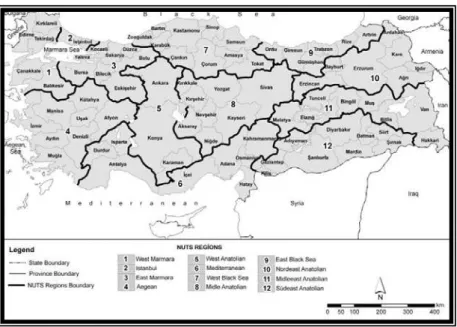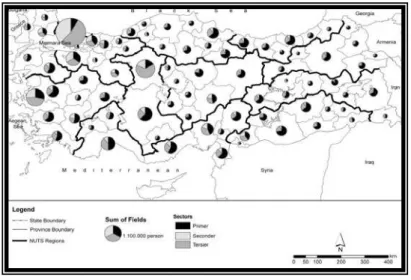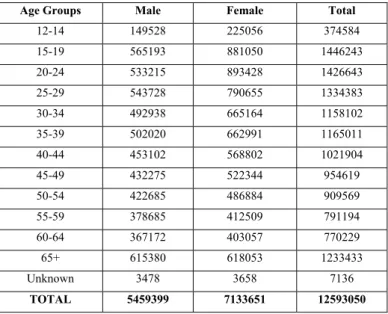И
K
Ш
BULLETIN OF THE SERBIAN GEOGRAPHICAL SOCIETY
И
2006.
LXXXVI -
р
. 2
YEAR 2006
TOME LXXXVI - N
о2
Originalan naučni rad UDC 911.3:314(56)
RÜYA BAYAR
MUTLU YILMAZ*
CHARACTERISTICS OF THE POPULATION EMPLOYED IN PRIMER SECTOR IN TURKEY
Abstract: Activities related to the production of raw material like agriculture, husbandry, forestry, fishery are called as primer activities. Especially people living in rural areas earn their livings on primer activities, mainly agriculture. Rural planning is inevitable for providing rural development which has an important place in all development of a country. And achievement of this planning depends on putting forth the characteristics of the population living in rural areas with its different aspects. Therefore, the requirements will be introduced more clearly and the increase in the welfare levels of the people living in rural areas will have been achieved.
To achieve the rural development and progress, in addition to the features like the size of agricultural products, products that are cultivated, activities like husbandry, forestry, hunting, etc. and the qualities of the enterprises in which these activities are carried out, policies applied, capital, market and technology, the characteristics of the population employed in this sector is also of importance. Considerin these points, what is aimed in this study is to put forth the characteristics of the population employed in primer sector in Turkey. According to the census results of the year 2000 in Turkey, 38% of the population is employed, and 48% of this work is in primer sector.
Key words: Rural population, Primer Sector, Turkey, Employed population, Sectoral Distribution
Introduction
Human beings have realized different economic activities since the time they existed in the world. Primer activities, one of the oldest economic activities, encompass agriculture, husbandry, forestry, hunting, and collecting. These activities which explain the economic benefit and production by processing natural resources like plant, animal, water and forests to meet the human requirements have kept their places within the oldest activities of history and the widest economic activities of our age. Primer activities meet the nourishment, accommodation, wearing needs and they also provide source for other economic sectors as well (Karabağ,S.; Şahin,S.,2006).
Improving technology has resulted in the change in human needs and the development of economic activities to meet these needs. Although this situation has caused gradual decrease in the population employed in primer sector, a significant part of the world population is still employed in this sector. In a general explanation, countries where the employees of the primer sector are in great number on the world arena are the under-developed countries. On the contrary, in under-developed countries the rate of the employees of this sector does not exceed 10% of the total population. For example, more than half of the total population of Pakistan and India work in primer sector, while this rate is approximately 3,6% in Japan and 4,5% in Australia (FAO,2006).
*
PhD Rüya Bayar, Ankara University, Faculty of Letters, Department of Geography, 06100, Sıhhiye, Ankara, Turkey, bayar@humanity.ankara.edu.tr
The situation in Turkey is not so different either. As according to the data of 2000, 19% of the population (67.803.927) works in primer sector, and when evaluated within the working population (25.997.141), this rate reaches 48% (12. 593.050).
Young woman population of age group 15-30 constitutes an important majority of the employees of primer sector in Turkey. And an important majority of them (66%) work in the status of unpaid family worker. When the employees of the primer sector are evaluated in terms of education level, it has been found that 56% of them are secondary school graduates and 23% of them are illiterate. In the light of these findings, the strongest aspect of the population employed in primer sector in Turkey is that it has a young and dynamic structure, and the weakest aspect of it is that the woman population working in the status of unpaid family worker is dominant in this sector. Migrations from the countryside to urban areas in Turkey constitute a big threat for the primer sector. However, the existence of a big population potential to be strengthened with the sectoral training constitutes the most important opportunity for the employees of primer sector.
An important majority of the employees of primer sector in Turkey live in rural areas. Rural areas are the places where economic activities are based highly on the valuation of natural resources and where the face-to-face relations are comparatively wider. Rural areas are the places where the life conditions are formed according to customs and traditions, and where technical and technological developments together with economic, social and cultural developments are slow and late (DPT, 2000). And it is generally this environment which determines the characteristics of the working population in primer sector.
Aim and Method
Rural areas in which the human- place interaction is felt most intensively are effective on the population living in these places. Changes and developments in the population directly affect the rural areas. In this context, in this study which, aims to put forth the characteristics of the population living in primer sector, the results of Census of 2000 Turkish Statistics Institution have been used, and age, gender, education levels, job statuses of the population employed in primer sector have been determined. In the light of the findings, what has been discussed is what kind of future will be in front of the population employed in primer sector.
Findings
Role of the Employees of Primer Sector within the Gainfully Employed Population in Turkey
2.000 4.000 6.000 8.000 10.000 12.000
1988 1989 1990 1991 1992 1993 1994 1995 1996 1997 1998 1999 2000 2001 2002 2003 2004 2005 2006
Fig. 1. Annual Distribution of the population employed in Primer activities
In Turkey, there has been an increase in the migrations from the countryside to urban areas especially since 1950s. As a result of this, some part of the population employed in primer sector has begun to move to other sectors. But in spite of this, other members of the family have continued to carry out economic activities and there has not been a remarkable decrease in the number of the people employed in this sector.
An important part of the employees of primer sector in Turkey deals with agricultural activities. For this reason, agricultural mechanization is important for the workforce in primer sector. However, that the land of Turkey is hilly, the height increases from west to east prevents the usage of the agriculture machineries in the same way everywhere. In relation to this, mechanization has created only a partial effect on the workforce of primer sector.
Hence, the most important factor which has affected the distribution of the employees of primer sector has been the fast increasing urbanization movements
Cities have big effects on the rural population. And the urbanization process which Turkey is in now has the most distinctive features of this effect. As a matter of fact, Schmitt,B. and Henry,M.S. 2000 have explained the effects of the cities according to their sizes on the surrounding rural population as follows:
Small urban places that have slow growing employment are associated with declining populations in nearby rural communes unless the local labor market area has expanded its job base. This is a general picture of decline throughout the Functional Economic Region. However, even small urban places with fast growing urban cores and fringes spread population to rural communes and this is reinforced by the expansions of employment in the labor market zone.
Medium size urban places that have at least average core and fringe employment growth rates have the strongest positive impacts on rural commune population change but even slow employment growth in medium centers boosts population change in nearby rural communes if the rural employment zone is expanding. In terms of urban population growth rates, a deconcentration pattern of fast fringe population growth rates is most likely to stimulate rural employment.
Large size urban places with faster fringe and core employment growth rates tend to increase rural population. If urban population is decentralizing through lower core and higher fringe growth rates, rural employment tends to increase. Otherwise there are possible backwash effects from urban employment growth on rural population change.
Urbanization rate is not same in each province of Turkey that is divided into 81 provinces in administrative terms (Fig 2). In relation with this, the number of the people employed in primer sector varies according to provinces. The main reason of this is that provinces are more developed in the service and industry areas. So, the rate of the people employed in primer sector is less in the west where the urbanization rate is high and service and industry sectors are dominant than the east (Fig. 3-4). For example; those cities also including Istanbul, the most densely populated city of Turkey (primer 8%, secondary 38%, tersier 54%), and the capital Ankara (primer 17%, secondary 18%, tersier 65%) have high urbanization rates and the sectors of service and industry are more developed than primer sector in these cities. But, in the eastern cities where rural population is dominant, the primer sector is in the first rank, and service sector is in the second.
Fig. 2. NUTS Regions of Turkey and its division of administration
As of 2000, 12. 593.050 people are employed in primer sector in Turkey. When a rational evaluation is made, it is seen that the rate of employees of primer sector within the gainfully employed population is below 20% in 2 cities (Istanbul and Ankara), between 20% and 35% in 2 cities, between 35% and 50% in 12 cities, and above 50% in 65 cities (Fig 4). This situation stresses out how important the primer activities are in Turkey.
Fig.3. Sectoral Distribution of Employment Population
Fig. 4. Primer Sectors Rates in Employment Population
The most important factor which restricts the economic activity areas in the east of Turkey is the altitude. For this reason, husbandry activities are wider in primer sector especially in Northeast and Middle East Anatolia Regions.
Age and Gender Structure of Employees of Primer Sector
Another remarkable point is that the population of age group above 65 has a value of 10% in primer sector (Table 1). The most important reason of this situation is the gradual decrease of young population in rural areas as a result of the migrations from the countryside to urban areas. This can be seen more clearly in rural areas, especially the ones surrounding metropolitans. People settling in metropolitans with the aims of working, giving more qualified education to their children return to their villages at weekends or in harvest period and support their families. So, people working in these rural areas in primer sector in the population of age above 65 take an important place.
Table 1. Employed population by occupation, age group and gender
Age Groups Male Female Total
12-14 149528 225056 374584
15-19 565193 881050 1446243
20-24 533215 893428 1426643
25-29 543728 790655 1334383
30-34 492938 665164 1158102
35-39 502020 662991 1165011
40-44 453102 568802 1021904
45-49 432275 522344 954619
50-54 422685 486884 909569
55-59 378685 412509 791194
60-64 367172 403057 770229
65+ 615380 618053 1233433
Unknown 3478 3658 7136
TOTAL 5459399 7133651 12593050
In Turkey, women compose 36.3%, and men compose 63.7% of the gainfully employed population. But in rural areas the situation is totally different. When the employees of primer sector are evaluated in terms of gender, it should be noted that woman population is dominant (Table 1). Especially, the disparity between the man and woman population of the age group 15-29 is more evident. The disparity between man and woman population of the age group above 65 is highly less.
Since 1950s, migrations from the countryside to urban areas have been effective on the population structures of cities, especially metropolitans. There have occurred changes in the gender structure of the gainfully employed population of rural areas which experienced emigrations. As a matter of fact, in the first stage it is the man population which composes the major part of the immigrants. As one result of this, works in rural areas are carried out by women. Also, the tasks that woman population has undertaken in the society, in the family and their education level prevent their being employed in different sectors.
Educational Levels of Employees in Primer Sector
examined in terms of gender, it is seen that the education level of the women who are dominant in this sector is lower.
Table 2. Employed population by occupation, literacy, education level and gender
Male Female
Illiterate 624795 2281889
Total of literate 4834604 4851762
No school completed 527677 654675
Primary School 3351304 3689465
Primary education 61626 48057
Junior high school 427819 210913
Vocational school at junior high school level 9663 4105
High School 311908 188166
Vocational school at high school level 91115 39472
Higher education 53490 16909
Education level unknown 0 2
Statuses of the Employees of Primer Sector in Their Jobs
67% of the population of primer sector in Turkey works as unpaid family worker and 29% works for his own account. The number of the people who work against remuneration and are in employer status is highly low (Table 3)
The social status of woman population composing the 57% (Table 1) of the employees of primer sector has gained importance day by day and their education level has increased. Although these factors made the employment of women possible in other areas rather than family workforce, work areas of women in rural areas have widened within the family workforce of primer activities, and man population has stayed at the status working for his own account.
Table 3. Employed population by occupation, employment status and gender
Male Female
Regular or casual employee 266367 148835
Employer 29453 37843
Self Employed 3185996 519873
Unpaid family worker 1977435 6427096
Unknown 148 4
As stated above, the widest activity type in primer sector is agriculture. And the widest business administration in agricultural enterprises in Turkey is that the land is directly processed by its owner (Bülbül,M.,Beşparmak,F.2002).
Result
sector as well. That the agricultural activity areas are used in accordance with the aim will contribute to the economy of country and also will be important for the development of the population working in this sector is also important.
Primer activities are generally carried out with traditional methods. However, training and making people conscious, who are employed in these activities, of the developments and technologies in this sector is also necessary. In addition to this, the improvement in the life standards of the people living in rural areas and bringing the necessary services to these areas will stop the migration from the countryside to urban areas and a qualified workforce for primer sector will have been obtained as well.
Women constitute only ¼ of the gainfully employed population in Turkey, whereas 57% of the total population working in primer sector is women. 89% of the women working in this sector are employed as unpaid family workers. Since the social status of woman in developing world has gained importance, the increase in education levels has given the possibility to the women to be employed in other areas except for family workforce (Bayar,R. 2006). With the increase in the education level of the woman population employed in primer activities and their participation into the employment in different economic sectors, the inequality between the rates of woman and man employed in primer sector will be removed, although partially..
Rural development policies determine the progress made as a result of the united efforts of society and state in order to develop economic, social and cultural opportunities of societies, to make these societies arrive at national life level, to provide their complete participation into national development (Bülbül,M.,Beşparmak,F.2002). So, it can not be considered that the state ignores the population working in primer sector within the policies it develops in this aspect. For this reason, by taking the characteristics and problems of the population into consideration, five strategies in general have been determined in the framework of National Development Target and Plans (DPT, 2000):
a. Making the rural population in organization whit participatory approaches and making this widespread and; developing the abilities of solving problems,
b. Making the main requirements (settled and mobile) as education, health, social security, access to water, transportation attainable for the rural population (capacity development)
c. Making the people living in rural areas reach continuous and sustainable income sources, increasing their entrepreneurship abilities, providing their competitiveness in market conditions
d. Sustainable management of natural resources, protection of environmental and rural inheritance
e. Strengthening the Non-governmental Organizations working in the field of rural development
To these ends, the quality of the population working in primer sector will be increased and so the sustainable usage of the natural resources will be achieved.
REFERENCES
Bayar,R. (2006): Avrupa Birliği ve Türkiye’de İktisaden Faal Nüfus İçerisinde Kadının Rolü ve Bölgesel Farklılıklar,
TUCAUM, IV. Ulusal Coğrafya Sempozyumu,Ankara.
Bülbül,M., Beşparmak,F. (2002): Türkiye ve Avrupa Birliği ülkelerinin tarımsal yapılarının karşılaştırılması, Ekin Dergisi, 21,
Türkiye Tarım Kredi Kooperatifleri Merkez Birliği Yayınları.
DIE,2003. 2000 Genel Nüfus Sayımı, Nüfusun Sosyal ve Ekonomik Nitelikleri, TC. Başbakanlık Devlet İstatistik Enstitüsü, Ankara.
DPT., 2000. 8.BYKP “Kırsal Kalkınma” ÖİK Raporu. Ankara.
FAO,2006. http://www.fao.org/statistics/menu1.asp
Karabağ,S., Şahin,S. (2006): Türkiye Beşeri ve Ekonomik Coğrafyası. Gazi Kitabevi, Ankara.
Özçağlar,A.,Bayar,R. (2006): The regional distribution of employed population in Turkey. Jubilee National Scientific
Conference with International Participation “20 years Union of Scientists in Bulgaria-Branch Smolyan” October 20th
-21st
2006, Smolyan.
Schmitt,B.,Henry,M.S. (2000): Size and growth of urban centers in French labor market areas: consequences for rural




